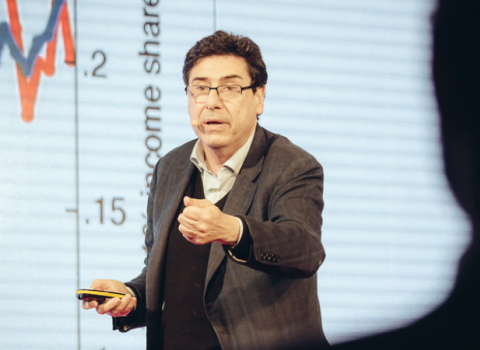February 2008, Groningen, Netherlands. Ben Feringa is working on his application for a grant from the newly-established European Research Council (ERC). He competes against 1,000 fellow scientists in the first call for Advanced Grants, aimed at researchers with more than 12 years-experience after their PhD. Five months after, the phone rings: he has been awarded €2.5 million over five years. The project: to build the first nano-car.
This was to be a culmination of long years of research. In 1999 Feringa invented the first molecular motor, an engine 80,000 times smaller than the thickness of a human hair, made from organic molecules.
“I started with switches”, Feringa told Science|Business. The aim was to get organic molecules to switch between 0 and 1, binary style, as the basis of a new type of computer storage. “We discovered by accident - more or less - that they not only switched but also turned. When you can turn something and you continue turning you have a rotary motor.”
Feringa and his team had put these motors into a range of nano devices, laying the foundations for materials that can change in response to an input of energy.
With the ERC grant, he took the technology to the next stage, and by 2011 had developed a nano-car with four molecular wheels.
One possible application is to use these as vehicles for the targeted delivery of medicines. Rather than expose the whole body, Ferringa says the nano-car could shield antibiotics whilst they are transported to the site of an infection and the drugs could then be light-activated. “You switch it on, it does its job and after 12 hours it’s off automatically.”
This would have advantages over systemic delivery of antibiotics, whether administered orally or intravenously, in that there would be fewer side effects and with less exposure to a drug it would take longer for bacteria to develop resistance. Feringa admits the idea is, “A bit science fiction still.” However, it has been shown to work in cellular models.
Science marathon
Feringa’s career as a researcher began in 1977. Although largely spent in academia, he had two spells in industry, working for the oil company Shell in the Netherlands and the UK. Along the way, he has been funded from various sources and won numerous awards.
Without grant support for the earlier work, Feringa would not have been in a position to fashion the nano-car. But, he says, it was the size of ERC grant that enabled him to focus on the task of taking the molecular motor and adding four molecular wheels, to create a designer molecular vehicle. Following on from his success in the first ever round of grants, Feringa subsequently won another ERC grant of €2.2 million, which will fund his work until 2021.
These are just two of the 7,000 grants the ERC has awarded in its first 10 years. Feringa was present at celebrations in Brussels last month to mark the ERC’s birthday and showcase its successes.
They developed the world's smallest machines
October 2016, Stockholm, Sweden. The Royal Swedish Academy of Sciences awards the Nobel Prize in Chemistry 2016 to Jean-Pierre Sauvage, University of Strasbourg, France; Fraser Stoddart, Northwestern University, Evanston, US (formerly at Birmingham University, UK); and Bernard Feringa, University of Groningen, the Netherlands “for the design and synthesis of molecular machines.”
A tiny lift, artificial muscles and minuscule motors. Between them, the trio has developed molecules with controllable movements, which can perform a task when energy is added. The research has “Taken chemistry to a new dimension,” the academy said.
The timeline highlights the need for sustained funding if Europe’s scientists are to make such fundamental breakthroughs.
The first step was taken by Sauvage in 1983, when he succeeded in linking two ring-shaped molecules together to form a chain. Normally, molecules are joined by strong covalent bonds in which the atoms share electrons, but in the chain they were instead linked by a freer mechanical bond. For a machine to be able to perform a task it must consist of parts that can move relative to each other. The two interlocked rings fulfill this requirement.
The second step was taken by Stoddart in 1991, when he threaded a molecular ring onto a thin molecular axle and demonstrated that the ring was able to move along the axle.
Building on these advances, Feringa was the first person to develop a molecular motor; in 1999 he got a molecular rotor blade to spin continually in the same direction. Using molecular motors, he has rotated a glass cylinder that is 10,000 times bigger than the motor and also designed the nano-car.
“In terms of development, the molecular motor is at the same stage as the electric motor was in the 1830s, when scientists displayed various spinning cranks and wheels, unaware that they would lead to washing machines, fans and food processors. Molecular machines will most likely be used in the development of things such as new materials, sensors and energy storage systems,” the academy said in its citation.
Although he has received other public funding, Feringa says the ERC grant was essential to his Nobel award. “[It] gave me the freedom to work with a substantial team on these very challenging, very tough projects. How to get from a rotary motor to something like a nano car? Phew, it was not an easy challenge!”
He encourages politicians to build on the substantial foundations that the ERC now has in place, to back Europe’s scientific talent and make Europe the global leader in science.
The ERC should not rest on its laurels however. One idea for the future would be extending the length of grants. Five years is enough to “make the next step” but in terms of major breakthroughs “it is rather a short time,” Feringa says. He first worked on molecular switches during his PhD, completed in 1977; it took another 34 years until the molecular car was a reality.
Politicians should “a bit more daring” in supporting pre-eminent European scientists, by providing substantial and long-term funding. “Give scientists the lead, encourage them to come with unconventional ideas and solutions, give them the freedom,” Feringa says.
But money is not everything. Feringa’s marathon was based on studying hard, rather like an elite athlete trains. “To win a gold medal at the Olympics you better focus on training damn hard and work harder than the others and then you get somewhere and then maybe you succeed,” he says.





 A unique international forum for public research organisations and companies to connect their external engagement with strategic interests around their R&D system.
A unique international forum for public research organisations and companies to connect their external engagement with strategic interests around their R&D system.